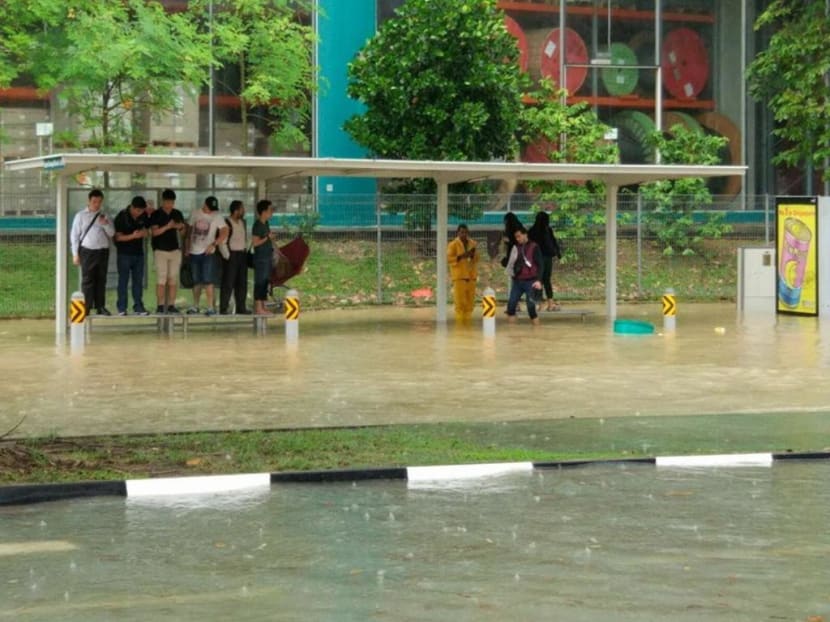'Not feasible' to build drains for all extreme rainfall scenarios: Masagos
SINGAPORE — Even as Singapore pours more effort and resources into flood prevention measures, it is “not feasible” to build drains here to accommodate all possible extreme rainfall scenarios as this would involve acquiring a lot more land as well as higher costs, Environment Minister Masagos Zulkifli told Parliament on Monday (Feb 5).

Commuters waiting for their respective buses are seen standing on benches to avoid the flood waters on Jan 8, 2018. Photo: Social media
SINGAPORE — Even as Singapore pours more effort and resources into flood prevention measures, it is “not feasible” to build drains here to accommodate all possible extreme rainfall scenarios as this would involve acquiring a lot more land as well as higher costs, said Environment and Water Resources Minister Masagos Zulkifli on Monday (Feb 5).
Citing the example of the Bedok Canal, Mr Masagos said that it would have to be widened to at least 62m — or the width of a 16-lane expressway — to deal with the “most extreme historical rainfall events”. This would displace the Bedok Park Connector and community spaces adjacent to the canal, and possibly affect surrounding private residential areas.
He was answering questions tabled in Parliament from five Members of Parliament, amid heightened public concerns over the recent flash floods.
On Jan 8, flash floods hit nine locations in the eastern side of Singapore, most of which were low-lying and susceptible to flooding. Only two — Tampines Road opposite Jalan Teliti, and Arumugam Road in Ubi — had a previous history of flash floods.
The floods were due to the Northeast Monsoon and made worse by an unexpected Sumatra squall which brought widespread thundery showers, with the eastern part of the island receiving the heaviest rainfall.
The highest recorded rainfall that morning was 118.8mm, which meant that half of Singapore’s average monthly rainfall in January fell in just four hours.
Four of the affected locations are served by roadside drains that lead to the Bedok Canal, which is currently being widened from its existing width of 38m to 44m at a cost of S$1.2 billion. These works, which began in 2016 and are expected to be completed by the first quarter of next year, means the canal will be wide enough to accommodate a 10-lane expressway.
But Mr Masagos added: “Even with this widening, we cannot guarantee that there will be no floods in future, as rainfall events of even higher capacity could still occur that exceed the design capacity. This is especially due to climate change.”
More intense rainfall will be the norm in the future, he pointed out. Flood risks from rainfall changes will increase in the next two to three decades due to global warming from greenhouse gases, according to a study by the Potsdam Institute for Climate Impact Research.
The annual number of days of very heavy rainfall — with maximum hourly rainfall exceeding 70mm — in Singapore has also been on the rise since 1980, according to national water agency PUB.
The Government, Mr Masagos noted, has to design “with practical considerations and not for extreme conditions all the time for all places”, as it will be “extremely costly but not needed most of the time”.
“The need for adaptation is significant, even in countries with good infrastructure such as Singapore,” Mr Masagos said.
To that end, the Government has invested S$1.2 billion in drainage improvement works since 2012, and will pump in another S$500 million over the next two to three years. Since 2012, drainage improvement works at 327 locations have been completed, with 22 more planned for this year.
On the Jan 8 flash floods, drainage improvement works are already being carried out at eight of the nine affected locations, Mr Masagos told the House. Works at the Tampines Canal between Upper Serangoon and Sungei Serangoon are expected to be completed by the third quarter of this year, and works at the Geylang River will be completed by the first quarter of next year.
For the ninth location at Tampines Avenue 12, a temporary construction access road built by the constructor had worsened the situation by obstructing the earth drain in an adjacent worksite.
The PUB has worked with the developer to improve drainage there, Mr Masagos disclosed. A permanent drainage system, built in tandem with the upcoming development project at the adjacent worksite, will serve as the longer term measure.
Responding to a supplementary question by Mr Murali Pillai (Bukit Batok Single Member Constituency), who asked how the ministry will oversee developers and construction companies, Mr Masagos said that contractors have to submit plans for drainage diversion to the PUB. For those who commit errors, like at Tampines Avenue 12, the ministry will take action by bringing them to court and fining them, he added.
And since flash floods cannot be completely eliminated, Mr Masagos advised members of the public to subscribe to the National Environment Agency’s and PUB’s SMS alerts or mobile apps for updates on impending heavy rain and water level in drains at designated locations.
While the PUB strives to give early warning to the public, weather systems in the equatorial region pose a forecasting challenge, he said. These weather systems comprise mainly convective thunderstorms which tend to be localised, develop rather suddenly, and are of short duration. This limits the lead time for issuing warnings of heavy rain and consequent flash floods.
Flash floods have occurred on four days in January this year. There were flash floods on 14 days last year, 10 in 2016 and six in 2015.
*CLARIFICATION: In an earlier version of this story, we reported that flash floods have occurred on three days in January this year. That is incorrect. The PUB has clarified that flash floods have occurred on four days in January.
PROTECTING CRITICAL INFRASTRUCTURE FROM EXTREME RAINFALL
Besides drainage improvement works, the PUB takes an approach called “source-pathway-receptor” to ensure the Republic’s critical infrastructure is well-protected from extreme rainfalls.
“Source” refers to where the rain falls, “pathway” refers to drains and “receptor” refers to the areas where floods may occur.
Measures to cope with “source” and “pathway” issues include detention tanks, which collect and store water from storms, potentially reducing the amount of storm water entering public drains during peak rainfall.
An example of this is the Stamford Detention Tank and the Stamford Diversion Canal, which will alleviate flooding in the Stamford Canal catchment area that covers the Orchard Road shopping belt.
The Stamford Detention Tank, to be completed by the second quarter of the year, will temporarily hold excess storm water from the drains. After the rain subsides, the water will be pumped back into the drains and discharged into Marina Reservoir.
Since 2014, developers have had to implement such source measures at all new and redevelopment projects that are 0.2 hectares or larger in size. These measures slow down surface runoff and reduce peak flow to the public drainage system by 25 to 35 per cent.
There have been about 500 submissions for plans to incorporate retention tanks, of which 138 have been completed.
For areas most at risk of flooding, the PUB stipulates that buildings should have features such as higher platform levels, crest protection and flood barriers to prevent floodwaters from damaging them.
Developers have to adhere to a minimum design standard to provide adequate drainage for buildings and infrastructure. The code of practice, last revised in December 2011, covers the minimum land reclamation levels, minimum crest and platform protection levels, and design standards for drains.
Following the 2011 revision, drainage design standards for new drains were increased to handle more intense storms. For example, the width of a typical roadside drain was increased from 1.5m to 1.8m.








